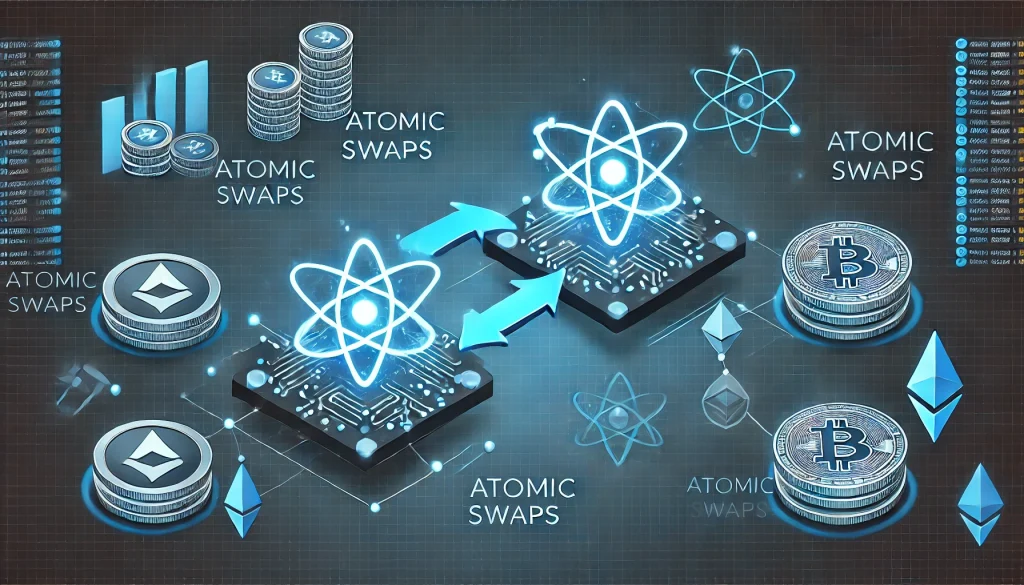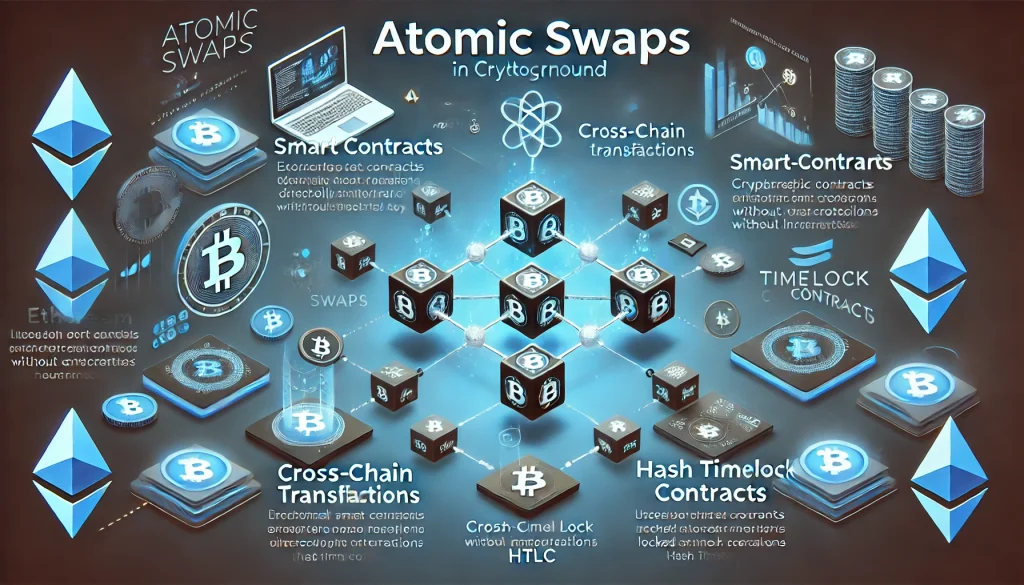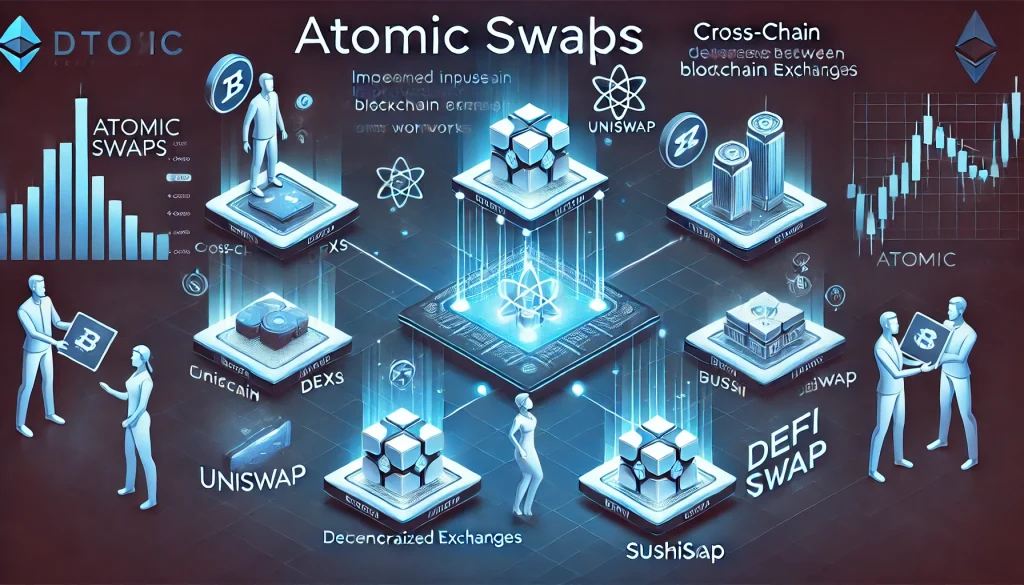
In cryptocurrency, Atomic Swaps are a groundbreaking innovation, enabling direct exchanges between users without third-party intermediaries. This mechanism boosts security and efficiency in decentralized finance (DeFi). As the crypto space expands, understanding Atomic Swaps is crucial for traders, offering insights into their benefits, limitations, and future potential.
What is an Atomic Swap?
An Atomic Swap allows users to exchange cryptocurrencies from different blockchains without needing a third party. It uses smart contracts to enable direct peer-to-peer transactions, ensuring either both parties complete the trade or the transaction cancels automatically, protecting against fraud or failure. The term “atomic” comes from computer science, meaning operations are fully completed or not executed at all. Also known as cross-chain or peer-to-peer swaps, they eliminate the middleman, reduce fees, and speed up asset transfers. With the rise of decentralized finance (DeFi), Atomic Swaps play a key role in advancing decentralized cryptocurrency trading.
Background

To understand Atomic Swaps in detail, it’s important to break down their key components and functionality within the cryptocurrency landscape. These swaps use smart contracts, which are self-executing agreements that process transactions only when specific conditions are met. These conditions ensure that both users involved in the swap either receive their respective assets or neither party receives anything, hence preventing theft or transaction manipulation.
This cross-chain swaps usually operate across two primary blockchain networks, enabling users to trade coins like Bitcoin for Ethereum, without intermediaries. Here’s a simplified process of how an Atomic Swap works:
- Initiation of Swap: One party creates a smart contract containing their cryptocurrency. This contract is locked with a cryptographic hash function, ensuring it can only be unlocked by the correct private key.
- Verification: The second party creates a matching contract, and the first party receives a hash key to unlock it.
- Exchange Completion: Both parties exchange their respective keys, unlocking each other’s contracts and completing the transaction.
An essential feature of Atomic Swaps is the use of Hash Timelock Contracts (HTLCs), which introduce a time constraint on the transaction. If either party fails to unlock the contract in time, the system automatically cancels the contract and refunds the original assets to their owners. This ensures swaps are either fully completed or canceled, preventing incomplete transactions.
Origins/History
Tier Nolan introduced the concept of Atomic Swaps in 2013. While it initially gained little attention, the idea resurfaced with the rise of decentralized finance (DeFi) in the late 2010s. Nolan’s proposal enabled cross-chain token swaps without relying on centralized exchanges. Traditionally, centralized exchanges posed security risks, high fees, and potential government interference. Atomic Swaps addressed these issues, paving the way for fully decentralized exchanges (DEXs) where users trade directly and securely using blockchain technology.
| Year | Event |
|---|---|
| 2013 | Tier Nolan proposes the concept of Atomic Swaps. |
| 2017 | First successful Atomic Swap between Bitcoin and Litecoin is completed. |
| 2020 | Widespread adoption of Atomic Swaps in DeFi projects and DEX platforms. |
Types of Atomic Swap
Atomic Swaps can be classified based on where they occur, either on-chain or off-chain.
- On-Chain Atomic Swaps occur directly on the blockchain, meaning that both parties’ transactions are recorded and verified by the network, providing greater security and transparency.
- Off-Chain Atomic Swaps occur outside of the blockchain, typically through a secondary layer or protocol. These swaps tend to be faster and more scalable but may come with certain trade-offs in terms of security.
Both types of swaps provide users with the flexibility to choose how they want to conduct their transactions based on factors like speed, security, and cost.
How Does an Atomic Swap Work?
The technical process behind an Atomic Swap involves cryptographic principles and smart contracts. Here’s a step-by-step look at how it works:
- Smart Contract Creation: A user initiates the Atomic Swap by creating a smart contract containing their cryptocurrency. This contract is protected by a hash function.
- Secret Key Generation: A unique cryptographic key is generated, which must be shared with the counterparty to unlock their assets.
- Counterparty’s Contract: The second party must also create a smart contract for their cryptocurrency. They are provided with the hash key needed to complete the transaction.
- Key Exchange: Both parties exchange their cryptographic keys, unlocking the smart contracts and successfully completing the Atomic Swap.
- Timeout Mechanism: If either party fails to complete their part of the transaction within a specified time, the swap is canceled, and assets are returned to their original owners.
Pros & Cons
| Pros | Cons |
|---|---|
| Decentralized: No need for third-party exchanges | Complex Setup: Requires understanding of smart contracts |
| Lower Fees: Eliminates intermediary fees | Slow Speed: On-chain swaps can be slower |
| Enhanced Security: Transactions are either completed or refunded | Limited Coin Support: Not all cryptocurrencies support Atomic Swaps yet |
| Cross-Chain Capability: Can be used across multiple blockchains | Requires Technical Knowledge: Users must have a good understanding of the process |
Companies Supporting Atomic Swaps
As Atomic Swaps gain popularity, several leading companies in the cryptocurrency space have integrated this technology to enhance decentralized trading. These companies are at the forefront of innovation, offering users the ability to conduct direct, peer-to-peer exchanges without relying on centralized entities. Below are some of the most prominent organizations leading the charge in Atomic Swap implementation.
Komodo
Komodo is a pioneer in Atomic Swaps, offering one of the first platforms for decentralized, cross-chain exchanges. Its decentralized exchange, AtomicDEX, is fully built on Atomic Swap technology, allowing users to trade cryptocurrencies directly from their wallets without needing third-party exchanges. AtomicDEX supports a wide range of blockchains, including Bitcoin, Ethereum, and lesser-known altcoins, ensuring secure and efficient cross-chain swaps. Komodo’s focus on privacy and decentralization makes it a trusted leader in cross-chain swap technology.
Decred
Decred, a cryptocurrency focused on decentralization, has integrated Atomic Swap functionality to minimize reliance on centralized exchanges. In 2017, it was among the first to successfully complete an Atomic Swap between Bitcoin and its native currency, DCR. By enabling cross-chain trades, Decred allows users to bypass exchange fees and reduce risks from hacking or mismanagement, enhancing liquidity and giving traders greater control over their assets.
Lightning Network
The Lightning Network, developed as a second-layer protocol, offers scalability for Bitcoin and facilitates off-chain Atomic Swaps, enabling faster and cheaper transactions outside the main blockchain. By using smart contracts, it ensures secure cross-chain swaps, making it a popular choice for traders seeking quick, secure exchanges without relying on traditional exchanges.
Thorchain
Thorchain is a decentralized liquidity network that enables cross-chain asset exchanges, making it a key player in Atomic Swaps. Unlike platforms tied to specific blockchains, Thorchain supports trading across multiple chains like Bitcoin, Ethereum, and Binance Coin. Users provide liquidity, and smart contracts execute this peer-to-peer swaps, reducing centralization risks. Its support for various tokens makes Thorchain a versatile platform for decentralized swaps across different blockchains.
Sparkswap
Sparkswap is a decentralized exchange (DEX) that uses Atomic Swaps to enable secure cryptocurrency trading. It leverages the Lightning Network for fast, cross-chain swaps with minimal fees. This allows Sparkswap to offer instant transaction settlements while maintaining the security of Atomic Swaps. Users can trade cryptocurrencies like Bitcoin and Litecoin without long waits or high fees, making Sparkswap a promising platform for decentralized trading.
Applications or Uses of Atomic Swaps

Cross-Chain Decentralized Exchanges
Atomic Swaps have revolutionized decentralized exchanges (DEXs) by allowing users to trade different cryptocurrencies directly. This capability eliminates the need for centralized exchanges, reducing fees, and minimizing the risks of hacking or government intervention.
Improved Interoperability
One of the primary uses of Atomic Swaps is to improve interoperability between different blockchain networks. Users can now move assets from one chain to another without relying on intermediaries. This significantly improves liquidity in the market.
DeFi Integration
As decentralized finance (DeFi) grows, platforms like Uniswap and SushiSwap increasingly use Atomic Swaps for instant token exchanges. This process has streamlined the movement of tokens across various DeFi protocols, boosting efficiency and user control.
Resources
- Investopedia. Atomic Swaps
- SuperMoney. Understanding Atomic Swaps
- CoinDesk. What are Atomic Swaps?
- The Motley Fool. How Do Atomic Swaps Work?
- Token Metrics. The Importance of Atomic Swaps
